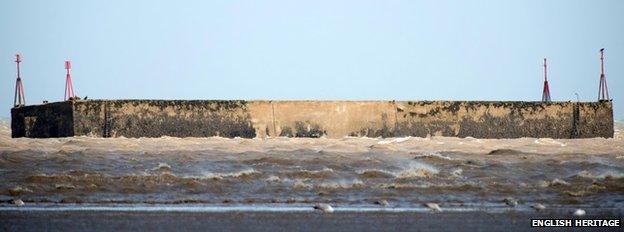Protection for D-Day landing floating harbour off Kent
- Published

The structure off Kent was not used in the D-Day landings because it was stuck fast in sand and silt
A structure off the Kent coast which was part of the Mulberry Harbour plan to support the World War Two D-Day landings has received protected status.
The Phoenix Caisson, abandoned off Littlestone-on-Sea, has been added to the National Heritage List for England as an Ancient Scheduled Monument.
Visible at low tide, it was built as a mobile port used by the Allies to land troops and arms in Normandy.
It is one of only six known examples of Phoenix caissons in British waters.
The others can be found in Portland Harbour, Dorset, Shoeburyness, in Essex, Langstone Harbour, Portsmouth and off Pagham, in West Sussex.
They were built between 1943 and 1944 ready to be towed across the English Channel.
However, the structure off the coast of Kent was "parked" prior to D-Day, but became stuck in sand and silt on the sea floor and was impossible to refloat.
Veronica Fiorato, designation team leader for English Heritage in the South, said it was a "tangible reminder of Operation Overlord and its vital contribution to British and world history".
"It has stayed exactly where it was parked during the Second World War and survives in very good condition, having lost only its anti-aircraft gun mounting," she said.
The Normandy landings 70 years ago were the first stage of the invasion of Nazi-occupied Europe.
By the end of D-Day on 6 June 1944, the Allies had established a foothold in France - an event that would eventually help bring the war to an end.
- Published6 June 2014

- Published5 June 2014

- Published5 June 2014

- Published5 June 2014
